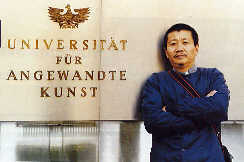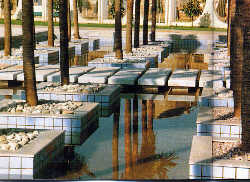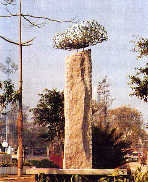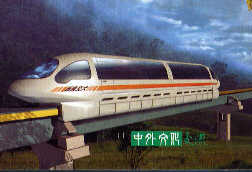 |
|
 |
| |
The Profile:
Xu Bochu, a native of Chengdu, is a sculptor, painter, print maker, potter, designer, and art professor. His art works were exhibited many times in Austria, Germany, Switzerland, Yugoslavia, Russia, Japan and China. He studied at Sichuan College of Fines Arts and Southwest Normal University in Chongqing in the 1980s. Granted a scholarship from the Austrian Ministry of Education, Xu Bochu went to study sculpture, pottery, print making and media arts at the prestigious National University for Applied Arts in Vienna from 1989 to 1995. He has been an art professor at Southwest Jiaotong University since 1996. |
|
 |
|
 |
As far as the public was concerned, arts and sciences belong to totally different worlds. Yet, to his own determination, Xu Bochu, a gifted artist, devoted himself to the challenge of exploring the mysterious territory of sciences.
Xu Bochu got the "Permanent Residency for Artists" in 1995 because as the first Chinese artist he was honored "The Outstanding Graduate Project" awarded by both the university and the National Department of Art Education in Austria. Not at all to his any regrets, he gave up the PR together with the enormous financial aid and chose to come back to his motherland.
Xu Bochu: Initially I went to Vienna in 1989 to participate in a pottery exhibition in Chanhans Gallery, and I wanted to take the chance to have a good look at Europe. At the exhibition, my artworks called the attention of the Ministry of Education, especially the prestigious sculpture Professor A. Hrdlicka of the National University for Applied Arts. My enthusiasm for learning grew and grew irresistibly as soon as I stepped on the campus, where the studying environment instantly impressed me. The teaching ideology and training methods, especially their ways of fostering the talented, which integrate arts with society, are totally different from those in China.
Austria is a small European country with very long history of Austro-Hungary and very changeful landscapes varying from mountains, hills to plains. The natural surroundings embrace people with a strong atmosphere of Paradise, inviting continuous inspiration and creation. No wonder why so many famous musicians have been fostered there. Beethoven lived in Vienna for the most of his life, moving more than 30 times in the picturesque and poetic city. Whenever I went back there, I was overwhelmed by its fathomless charm. The natural, aristocratic and aesthetic Vienna always purifies my heart and soul.
 Xu Bochu had taught arts for years in Southwest China Normal University before he went to Austria. Yet taking it as a big challenge to set up a specialty of art in a university of engineering, he decided to work at Southwest Jiaotong University after his overseas studies.
Xu Bochu had taught arts for years in Southwest China Normal University before he went to Austria. Yet taking it as a big challenge to set up a specialty of art in a university of engineering, he decided to work at Southwest Jiaotong University after his overseas studies.
Xu Bochu: Conventionally, the specialties of arts are established in universities of liberal arts in China. After all, art is much inter-linked with history, literature, philosophy, etc., and is usually paid more attention by the university authorities. Therefore, the criteria of the subject evaluation, the ideology and conditions of running the school are easier to be approved and developed. SWJU is an old university of engineering with a history of more than 100 years, renowned for bridge building and road paving. The relation between art and the other subjects used to be rather vague. However, strongly influenced by the ideology of "Great Art" in the West, personally, I think it is a prejudice to regard art simply as something amazing, enjoyable and colorful. With the development of the society, politics, economy, culture, history, and even science and technology are getting more and more mixed up, merged and intersected, embodying, expressing and reflecting each other.
Generally speaking, in China universities of engineering are not so influenced by humanities in its high quality as they are in the West. With the current multi-cultural backgrounds, talent fostering has become the foundation of social culture instead of the means of social service. The comprehensive quality education of individual has been highlighted not only in the West but also in China.
Linking arts with sciences hand in hand, Xu Bochu has been successful in the exterior and interior designs of the sensational Magnetic Suspension Trains and other projects for the National Ministry of Railway, together with numerous city-planning programs in Southwest China.
Xu Bochu: Of course, it is impossible for the specialty of art, as a "newcomer", to contend with the powerful specialties of construction, machinery and electric engineering. However, I have been trying my best to make art accepted, approved, combined with, and infiltrated by other different subjects.
On the very next day after I came back to China, I started charging myself with the task of designing the interior decoration of the special train for Chinese vice-premiers who were to participate in the ceremony of the hand-over of Hong Kong in 1997. My design was favorably adopted and chosen from dozens of designs nationwide. In 1997, I took charge of the exterior and interior designs of the experimental MST-2 (Magnetic Suspension Train), and in the meantime, the MST on the experimental track in Qingcheng Mountain. Both of them were exhibited in Beijing as "The National Outstanding Construction Achievements". In addition, I was responsible for the sculpture and environment designs for the "Monument Garden of Nan-kun Railway" for the Ministry of Railway in 1999, and the interior design of the 270m High-speed Passenger Train for the Ministry of Railway in 2000. Besides that, I managed to finish numerous planning and designs in Chengdu, Kunming and other cities in southwest China.
The purpose of all of my efforts is to pursue the approval of art as a subject in the university and integrate art with engineering. "Science and art are like the two sides of a coin." I agree with it fully.
During "The Cultural Revolution", Xu Bochu used to be a carpenter, blacksmith and stonemason when he settled in the remote mountainous countryside in Sichuan. Although affected by the concepts of the Western art, yet his artworks still strongly reflect and effectively express his own personal identity of culture as a native of Chinese.
 Xu Bochu: In my point of view, the best art of any nation or culture is the very art of the very nation or the very culture. The generation of people at my age is usually inclined to keep up strong native characteristics, no matter how long we have lived abroad or how active they are engaged in art creation overseas. Probably it has something to do with our personal experiences. Owing to the profound impact of our native Culture on us before we went abroad, we have been nourished by the overwhelming Chinese culture. Our outlook on life is so determined that it is almost impossible to be changed. As a result, the coexistence of Chinese culture and external culture in our artworks is rather natural. Born in China and deeply rooted in the soil of Chinese culture, we are reluctant to abandon our native culture in a rash. Let alone the strong touch of the oriental civilization, especially the abundance and extensiveness of Chinese culture, which is incomparable. The culture of many Asian countries, especially the islands countries, such as Japan, Korea and Vietnam, is more or less influenced by Chinese culture. Yet the culture of India, which is very much affected by its powerful religions, also makes a strong voice in the world of art.
Xu Bochu: In my point of view, the best art of any nation or culture is the very art of the very nation or the very culture. The generation of people at my age is usually inclined to keep up strong native characteristics, no matter how long we have lived abroad or how active they are engaged in art creation overseas. Probably it has something to do with our personal experiences. Owing to the profound impact of our native Culture on us before we went abroad, we have been nourished by the overwhelming Chinese culture. Our outlook on life is so determined that it is almost impossible to be changed. As a result, the coexistence of Chinese culture and external culture in our artworks is rather natural. Born in China and deeply rooted in the soil of Chinese culture, we are reluctant to abandon our native culture in a rash. Let alone the strong touch of the oriental civilization, especially the abundance and extensiveness of Chinese culture, which is incomparable. The culture of many Asian countries, especially the islands countries, such as Japan, Korea and Vietnam, is more or less influenced by Chinese culture. Yet the culture of India, which is very much affected by its powerful religions, also makes a strong voice in the world of art.
In the end of the 20th century, more and more Chinese artists went to the West for advanced studies. Some of them come back to China while the others stay overseas. According to Xu Bochu, artists cannot be simply distinguished between domestic and abroad. Never for one second in his life, he regrets his choice on the road of arts.
Xu Bochu: As for the word 'choice', the generation of people of my age used to have no choice mostly. We couldn't choose our professions, jobs, hobbies, or even marriage when we were young. Although we have the opportunities to choose now, yet we have few choices left actually being limited by our age, courage and social responsibilities. However, it was probably because of the meager choices in our life, we tend to be especially determined. As we know that the word 'U-turn' doesn't exist in our dictionary.
In my point of view, the most important thing for an artist is to gain experiences and feelings from life. To tell you the truth, sometimes I am under pressure, as I realize that fixed environment and a permanent job may hold back an artist's sensation and instinct. It will be a disaster for him if his feelings and passions fade away. With the increasing globalization of economy, culture tends to be more and more diversified with multi-directions. Therefore, interaction and exchange between China and the world get more and more significant. That's why we keep up exchange programs for the artists from the SWJU and the National University for Applied Arts in Vienna since 1997. The eye-opening experiences not only widen the artists' outlooks but also help a lot to improve the construction and development of art as a subject in both universities.
Xu Bochu counts himself lucky to witness the unprecedented changes in Chinese art history over the past two decades. It is amazing that Chinese contemporary art is a dynamic and exciting world brimming with vigor, vibration and movement, which give more opportunities and challenges to him and any other artists in China.
Xu Bochu: Sure, when I was an art student in China, I used to pay a lot of attention to the techniques and skills. The moment when the door of Chinese culture wide opened up, numerous schools of Western philosophy, ideology and art rushed in. I was amazed at the splendid history of the Western art. I started thinking over the essence of art and the significance of life as an artist. Personal experience and identity become highlighted in my artworks. Especially after years of studying in Europe, I have been very much influenced by the diversified styles of Western arts. 
Generally, there is always a mainstream in the world of art. Most likely it expresses art in an experimental, radical and exploratory art language. Yet individually, different artists are affected by different schools of art in social trends, totally depending on personal taste. Artists usually take the risk of exploring egos in various ways: traditionally, aesthetically, radically, or multi-culturally. They become intoxicated by the techniques and expressions of art that can touch them. Of course, they hope that their artworks can be approved, appreciated and even admired in the art history.
As for myself, I used to think art is ideal, sacred and paramount. As purely spiritual work, art is difficult to be evaluated commercially. Yet now I understand that eventually art should be restored to life and accepted by the public. In the final analysis, art is the expression of the experience and understanding of life. Therefore, art should nestle closely up to and give the concrete vein to our life.
